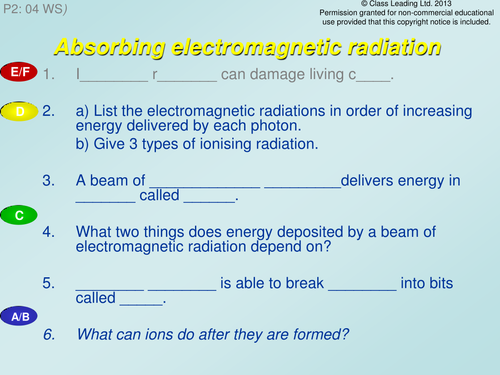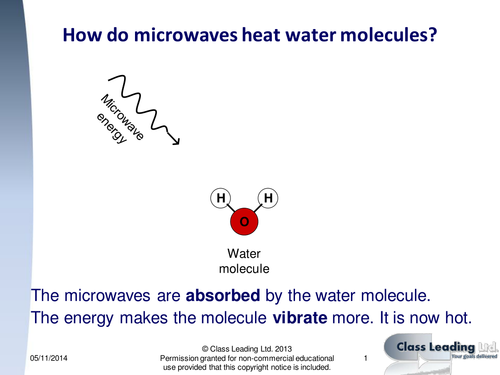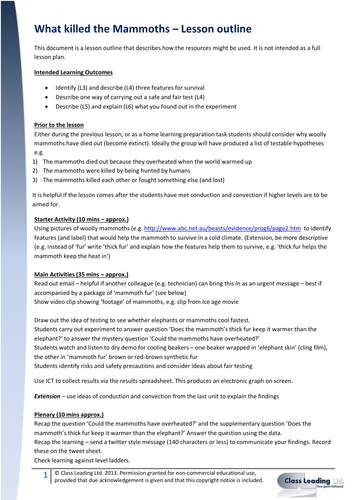314Uploads
260k+Views
194k+Downloads
Physics

Experiment: UV and washing powder
In this video, which is aimed at KS4 pupils, washing powder is shown under an ultraviolet lamp. This shows the fluorescence from the washing powder as the UV light is absorbed and visible light is emitted from the powder, making it appear much brighter than the washing powder would be if it was simply reflecting the light.
This resource is part of a sequence with the following three other resources:
EM spectrum grid https://www.tes.com/teaching-resource/resource-6341301
EM spectrum sort cards https://www.tes.com/teaching-resource/resource-6341302
IR remote control https://www.tes.com/teaching-resource/resource-12952897
This resource

Experiment - melting ice & freezing wax
In this video, which is aimed at KS3 pupils, a video is shown with changes of state of matter for ice and wax.
The melting ice takes place on a two surfaces, a conductive surface (aluminium pan) and and an insulating surface (wooden chopping board). The video shows how the time of melting differs for each surface.
The experiment also shows wax freezing on the same two surfaces.
Pupils can compare the times and suggest explanations as to why the times differ. The video includes prompts to support their thinking.

Experiment: Making a fruit 'battery'
In this video, which is aimed at KS3/4 pupils, a fruit ‘battery’ is shown. The ‘battery’ has been made with different pairs of metals for the electrodes. Readings are shown in the video for the potential difference (voltage) across the electrodes for each pair. Pupils can then consider the connection between reactivity of the metals and the results of the experiment.

Experiment: Stretching a rubber band
This is a video aimed at pupils in KS3/4 that shows an experiment of a rubber band being stretched. The stretching happens when masses are added to the end of the band.
There is an introduction the experiment, which aims to help pupils understand the most important ideas.
After each mass is added the rubber band, the video zooms in on the scale to allow pupils to read this.
This can form the basis of a graphing activity to find the relationship between the masses added and the extension of the rubber band. Unlike the linear relationship of the spring, there are some differences in the way the band extends, particularly towards the start and end of the experiment.
There is a PowerPoint slideshow to help focus the activity if used in a classroom.
This resource forms part of a sequence with two other resources:
https://www.tes.com/teaching-resource/experiment-measuring-the-weight-of-masses-12952546
https://www.tes.com/teaching-resource/experiment-stretching-a-metal-spring-12952559
This resource

Experiment: Measuring the weight of masses
This video is aimed at pupils at KS3/4. It shows a video of an experiment where 100g masses are put onto a forcemeter, calibrated in newtons. It allows the measurement of the force for each mass. There are questions to focus pupils on the relationship between the masses and the weight. It can be used as a graphing exercise to calculate the value of the constant ‘g’.
There is a PowerPoint slideshow to help focus the activity if used in a classroom.
This resource forms part of a sequence with two other resources:
This resource
https://www.tes.com/teaching-resource/experiment-stretching-a-metal-spring-12952559
https://www.tes.com/teaching-resource/experiment-stretching-a-rubber-band-12952565

Experiment - flying bat circular motion
This video is aimed at pupils in KS4 and students in KS5. It shows a model flying bat, attached by a string to a point, flying in a circle. The video poses questions about the motion of the bat and the forces, including the centripetal force, involved in the motion.
The activity includes a PowerPoint slideshow with questions and answers.

Absorbing EM radiation - graded questions
This activity contains a powerpoint with graded questions & answers and matching pupil activity sheets, designed to be used at the end of a lesson and/or the start of the next lesson to review previous learning. The questions are based on the previous OCR 21st Century Science Specification unit P2, although could be used with other exam boards.
Clicking through the show reveals answers one a time. These reduce to A5 easily, the ideal size for most pupils. Please note grades are approximate.

Climate change (1) - graded questions
This activity contains a powerpoint with graded questions & answers and matching pupil activity sheets, designed to be used at the end of a lesson and/or the start of the next lesson to review previous learning. The questions are based on the previous OCR 21st Century Science Specification unit P2, although could be used with other exam boards.
Clicking through the show reveals answers one a time. These reduce to A5 easily, the ideal size for most pupils. Please note grades are approximate.

Microwave heating - animated powerpoint model
This is a simple single slide with an animated water molecule to represent what happens when water absorbs microwave radiation.
With more able learners, they could evaluate the model used for accuracy.

Home experiment: Infrared remote control
In this video, which is aimed at KS4 pupils, you can see an infrared remote control. The remote control is pointed at the camera and a button is pressed. You can see the signal from the remote control, even though it would be invisible if you were to look at it with your eyes directly. The camera used is sensitive to infrared and so shows it up on screen. Pupils may be able to repeat this experiment at home, although some cameras include infrared filters to reduce glare from sunlight, so it may not show up properly.
This resource is part of a sequence with the following three other resources:
EM spectrum grid https://www.tes.com/teaching-resource/resource-6341301
EM spectrum sort cards https://www.tes.com/teaching-resource/resource-6341302
This resource
UV lamp and washing powder https://www.tes.com/teaching-resource/resource-12952892

Do Try This At Home: Modelling a 'day' - daytime and night-time
This is a video to support the teaching of space to KS2 pupils. In the video, it describes how you can model daytime and night time to help pupils understand that this is caused by the rotation of the Earth. It also explains the changes that happen during the seasons.

Video - Why do we need to learn about space
This video is aimed at KS2/3 pupils and helps them to think about why they need to learn about space.

Video Experiment: A pair of forcemeters
In this video, you will see an experiment where a pair of identical forcemeters are pulled apart. There are questions that focus pupils on the force pair interaction. It asks pupils to make predictions, then shows what happens in the experiment.

Thinking About: Energy stores & pathways in toys
In this video, which is aimed at pupils in KS3/4, there are a series of toys shown in action. Pupils are asked to consider the energy stores that the toys represent.

Thinking About: A hot-air balloon rising
In this video, which is aimed at KS3/4 pupils, a hot air balloon is shown rising. Pupils are asked to describe and explain what they see and are reminded that there is a heater in the balloon. This can be used as part of a lesson about density, where pupils can use the idea of the hot air being less dense than the cooler air around it, therefore causing the balloon to float.

Experiment: Tangerine mystery
In this video, which is aimed at pupils in KS4, a tangerine is shown. Firstly it is weighed, then is shown floating on water. Then it is peeled, weighed again, and then pupils are asked to predict what will happen when it is placed in water. There is an element of surprise in the video that aims to help challenge preconceptions that they might hold.

Experiment: Stretching a metal spring
This is a video aimed at pupils in KS3/4 that shows an experiment of a metal spring being stretched. The stretching happens when masses are added to the end of the spring.
There is an introduction the experiment, which aims to help pupils understand the most important ideas.
After each mass is added the spring, the video zooms in on the scale to allow pupils to read this.
This can form the basis of a graphing activity to find the relationship between the masses added and the extension of the spring.
There is a PowerPoint slideshow to help focus the activity if used in a classroom.
https://www.tes.com/teaching-resource/experiment-measuring-the-weight-of-masses-12952546
This resource
https://www.tes.com/teaching-resource/-12952565

What killed the Mammoths
This is a collection of resources that would work well as a lesson. A lesson outline is provided showing how the resources might be used together. There is an email designed to set the scene and for use as as a ‘hook’. There are also sheets for learners to summarise their learning (tweet).
You may want to supplement the resources with pictures of a woolly mammoth (link only due to copyright restrctions) and video ‘footage’ e.g from Ice Age movie.
This was designed as lesson for a KS3 nurture group although would be suitable for KS2 or other KS3 groups with adaptation.
Please note that this is a non-editable version. A fully editable premium version is also available.

Using graphs to show motion - graded questions
This activity contains a powerpoint with graded questions & answers and matching pupil activity sheets, designed to be used at the end of a lesson and/or the start of the next lesson to review previous learning. The questions are based on the previous OCR 21st Century Science Specification unit P4, although could be used with other exam boards.
Clicking through the show reveals answers one a time. These reduce to A5 easily, the ideal size for most pupils. Please note grades are approximate.

Weight & Reaction - graded questions
This activity contains a powerpoint with graded questions & answers and matching pupil activity sheets, designed to be used at the end of a lesson and/or the start of the next lesson to review previous learning. The questions are based on the previous OCR 21st Century Science Specification unit P4, although could be used with other exam boards.
Clicking through the show reveals answers one a time. These reduce to A5 easily, the ideal size for most pupils. Please note grades are approximate.




















